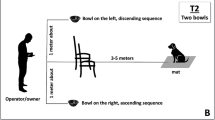Summary
-
1.
We derived audiograms from recordings of multiunit activity in the torus semicircularis of 10 males and 6 females of the spring peeper from central Missouri, USA. We used free-field stimulation with tone bursts that had temporal properties similar to typical advertisement calls and that ranged in frequency from 500–6000 Hz.
-
2.
Audiograms from different electrode positions in the same animal had the same general shape. There was no evidence of tonotopy.
-
3.
Audiograms showed two regions of maximal sensitivity: a low-frequency region (500–700 Hz); and a high-frequency region (2000–4000 Hz). Absolute thresholds and frequencies of maximum sensitivity varied considerably from individual to individual.
-
4.
Audiograms derived from all individuals of each sex indicated that in the high-frequency region, corresponding to the frequency range of advertisement calls, males were more broadly tuned than females. However, tuning in both sexes was relatively weak, and the data predict relatively little selectivity in behavioral responses over the entire range of variation in frequency of the advertisement call in local populations.
-
5.
The results are discussed in terms of behavioral experiments with both males and females from the same populations in central Missouri. We show that merely summarizing the audiograms based on estimates of minimum thresholds of a population or species may mask significant individual differences in tuning. Moreover, most behavioral studies are conducted at playback levels considerably above threshold. For these reasons, behavioral selectivity is not always accurately predicted by inspection of “average” audiograms.
Similar content being viewed by others
Abbreviations
- AP :
-
amphibian papilla
- BP :
-
basilar papilla
- SPL :
-
sound pressure level in decibels (dB) re 20 μPa
References
Brenowitz EA, Wilczynski W, Zakon HH (1984) Acoustic communication in spring peepers: Environmental and behavioral aspects. J Comp Physiol A 155:585–592
Doherty JA, Gerhardt HC (1984) Evolutionary and neurobiological implications of selective phonotaxis in the spring peeper (Hyla crucifer). Anim Behav 32:875–881
Eggermont JJ (1988) Mechanisms of sound localization. In: Fritzsch B, Ryan MJ, Wilczynski W, Hetherington TE, Walkowiak W (eds) The evolution of the amphibian auditory system. John Wiley and Sons, New York, pp 307–336
Forester DC, Czarnowsky R (1985) Sexual selection in the spring peeper, Hyla crucifer (Amphibia, Anura): Role of the advertisement call. Behaviour 92:112–128
Gerhardt HC (1991) Female mate choice in treefrogs: static and dynamic acoustic criteria. Anim Behav 42:615–635
Gerhardt HC, Diekamp B, Ptacek M (1989) Inter-male spacing in choruses of the spring peeper, Pseudacris (Hyla) crucifer. Anim Behav 38:1012–1024
Keddy-Hector A, Wilczynski W, Ryan MJ (1992) Call patterns and basilar papilla tuning in cricket frogs. II. Intrapopulational variation and allometry. Brain Behav Evol (in press)
Narins PM, Capranica RR (1976) Sexual differences in the auditory system of the treefrog, Eleutherodactylus coqui. Science 192:378–380
Pinder AC, Palmer AR (1983) Mechanical properties of the frog ear: Vibration measurements under free and closed-field acoustic conditions. Proc R Soc London B 219:371–396
Ryan MJ, Perrill SA, Wilczynski W (1992) Auditory tuning and call frequency predict population-based mating preferences in the cricket frog, Acris crepitans. Am Natur (in press)
Wilczynski W, Zakon HH, Brenowitz EA (1984) Acoustic communication in spring peepers: Call characteristics and neurophysiological aspects. J Comp Physiol A 155:577–584
Zakon HH, Wilczynski W (1988) The physiology of the anuran eighth nerve. In: Fritzsch B, Ryan MJ, Wilczynski W, Hetherington TE, Walkowiak W (eds) The evolution of the amphibian auditory system. John Wiley and Sons, New York, pp 125–155
Author information
Authors and Affiliations
Rights and permissions
About this article
Cite this article
Diekamp, B.M., Gerhardt, H.C. Midbrain auditory sensitivity in the spring peeper (Pseudacris crucifer): correlations with behavioral studies. J Comp Physiol A 171, 245–250 (1992). https://doi.org/10.1007/BF00188931
Accepted:
Issue Date:
DOI: https://doi.org/10.1007/BF00188931




